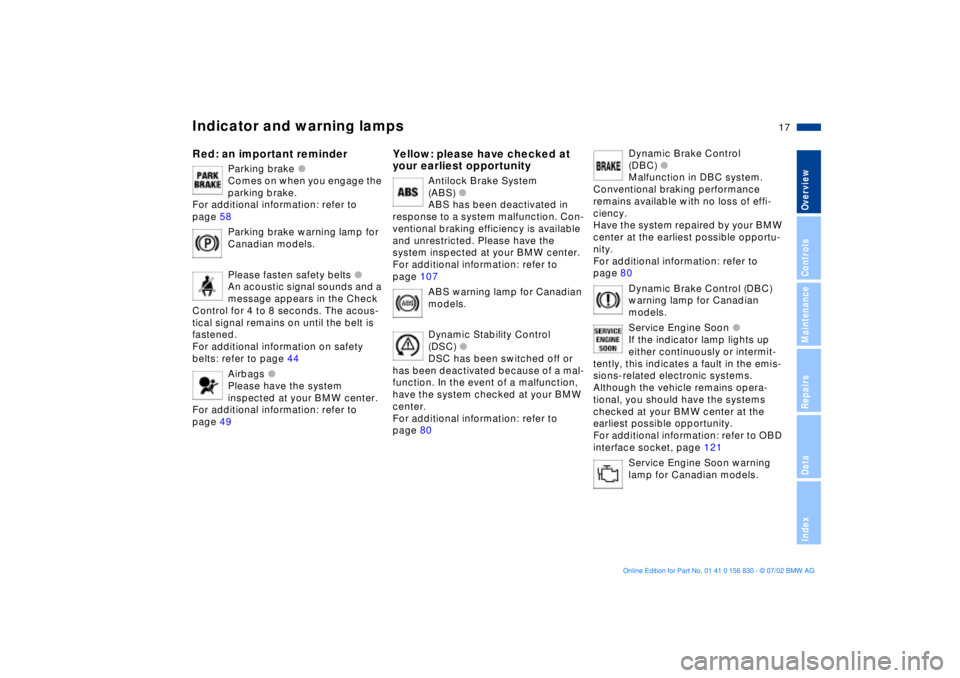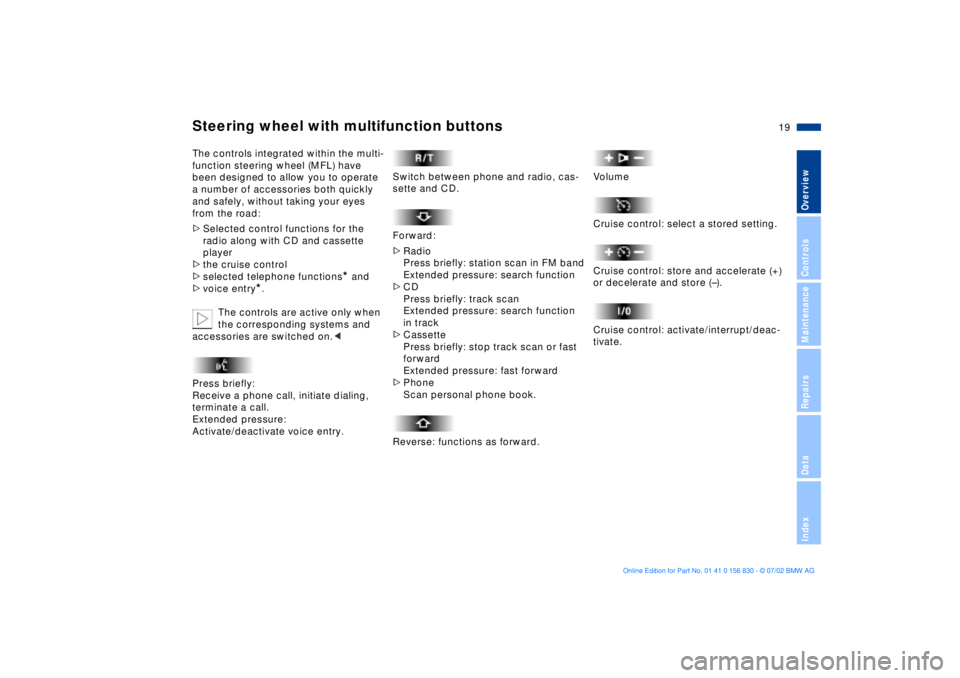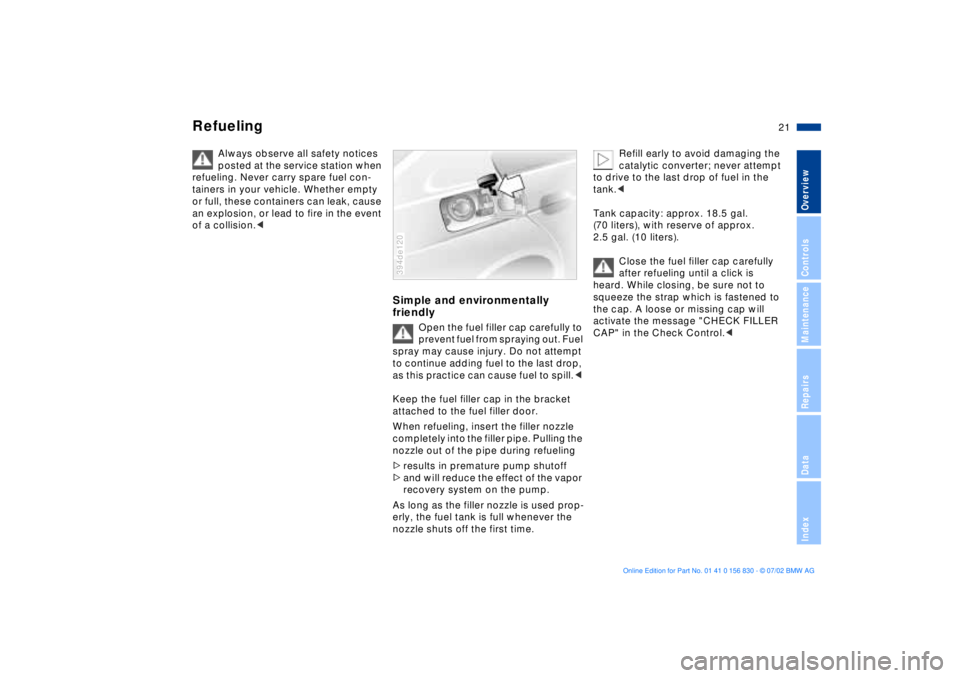Page 13 of 155
13n
OverviewControlsMaintenanceRepairsDataIndex
Overview
Controls and features
Operation, maintenance
Owner service procedures
Index Technical data
Overview
Page 15 of 155
15n
OverviewControlsMaintenanceRepairsDataIndex
1 Fuel gauge 64
2 Indicator lamp for turn signal
indicator18
3 Speedometer
4 Indicator lamp for high beams18
5 Tachometer and engine oil
temperature gauge64
6 Coolant temperature gauge657 Indicator and warning lamps16
to 18
8 CHECK button66
9 Outside temperature display63
10 Indicator lamp for Dynamic Stability
Control (DSC)17
11 Trip odometer6312 Check Control display66
13 Odometer63
14 Service Interval Display65
15 Trip odometer, reset to zero63
16 Indicator and warning lamps16
to 18
Instrument cluster
39mus004
Page 17 of 155

17n
OverviewControlsMaintenanceRepairsDataIndex
Indicator and warning lamps
Red: an important reminder
Parking brake
l
Comes on when you engage the
parking brake.
For additional information: refer to
page 58
Parking brake warning lamp for
Canadian models.
Please fasten safety belts
l
An acoustic signal sounds and a
message appears in the Check
Control for 4 to 8 seconds. The acous-
tical signal remains on until the belt is
fastened.
For additional information on safety
belts: refer to page 44
Airbags
l
Please have the system
inspected at your BMW center.
For additional information: refer to
page 49
Yellow: please have checked at
your earliest opportunity
Antilock Brake System
(ABS)
l
ABS has been deactivated in
response to a system malfunction. Con-
ventional braking efficiency is available
and unrestricted. Please have the
system inspected at your BMW center.
For additional information: refer to
page 107
ABS warning lamp for Canadian
models.
Dynamic Stability Control
(DSC)
l
DSC has been switched off or
has been deactivated because of a mal-
function. In the event of a malfunction,
have the system checked at your BMW
center.
For additional information: refer to
page 80
Dynamic Brake Control
(DBC)
l
Malfunction in DBC system.
Conventional braking performance
remains available with no loss of effi-
ciency.
Have the system repaired by your BMW
center at the earliest possible opportu-
nity.
For additional information: refer to
page 80
Dynamic Brake Control (DBC)
warning lamp for Canadian
models.
Service Engine Soon
l
If the indicator lamp lights up
either continuously or intermit-
tently, this indicates a fault in the emis-
sions-related electronic systems.
Although the vehicle remains opera-
tional, you should have the systems
checked at your BMW center at the
earliest possible opportunity.
For additional information: refer to OBD
interface socket, page 121
Service Engine Soon warning
lamp for Canadian models.
Page 19 of 155

19n
OverviewControlsMaintenanceRepairsDataIndex
Steering wheel with multifunction buttons
The controls integrated within the multi-
function steering wheel (MFL) have
been designed to allow you to operate
a number of accessories both quickly
and safely, without taking your eyes
from the road:
>
Selected control functions for the
radio along with CD and cassette
player
>
the cruise control
>
selected telephone functions
*
and
>
voice entry
*
.
The controls are active only when
the corresponding systems and
accessories are switched on.
<
Press briefly:
Receive a phone call, initiate dialing,
terminate a call.
Extended pressure:
Activate/deactivate voice entry.
Switch between phone and radio, cas-
sette and CD.
Forward:
>
Radio
Press briefly: station scan in FM band
Extended pressure: search function
>
CD
Press briefly: track scan
Extended pressure: search function
in track
>
Cassette
Press briefly: stop track scan or fast
forward
Extended pressure: fast forward
>
Phone
Scan personal phone book.
Reverse: functions as forward.
Volume
Cruise control: select a stored setting.
Cruise control: store and accelerate (+)
or decelerate and store (Ð).
Cruise control: activate/interrupt/deac-
tivate.
Page 21 of 155

21n
OverviewControlsMaintenanceRepairsDataIndex
Refueling
Always observe all safety notices
posted at the service station when
refueling. Never carry spare fuel con-
tainers in your vehicle. Whether empty
or full, these containers can leak, cause
an explosion, or lead to fire in the event
of a collision.<
Simple and environmentally
friendly
Open the fuel filler cap carefully to
prevent fuel from spraying out. Fuel
spray may cause injury. Do not attempt
to continue adding fuel to the last drop,
as this practice can cause fuel to spill.<
Keep the fuel filler cap in the bracket
attached to the fuel filler door.
When refueling, insert the filler nozzle
completely into the filler pipe. Pulling the
nozzle out of the pipe during refueling
>results in premature pump shutoff
>and will reduce the effect of the vapor
recovery system on the pump.
As long as the filler nozzle is used prop-
erly, the fuel tank is full whenever the
nozzle shuts off the first time.
394de120
Refill early to avoid damaging the
catalytic converter; never attempt
to drive to the last drop of fuel in the
tank.<
Tank capacity: approx. 18.5 gal.
(70 liters), with reserve of approx.
2.5 gal. (10 liters).
Close the fuel filler cap carefully
after refueling until a click is
heard. While closing, be sure not to
squeeze the strap which is fastened to
the cap. A loose or missing cap will
activate the message "CHECK FILLER
CAP" in the Check Control.<
Page 23 of 155
23n
OverviewControlsMaintenanceRepairsDataIndex
Tire inflation pressureBMW Tires
All pressure specifications in
the table are indicated in psi
(kilopascal) with cold tires
(cold = ambient temperature)
M5245/40 ZR 18 35 (240) - 44 (300) -
275/35 ZR 18 - 38 (260) - 48 (330)
235/45 R 17 94 H M+S 35 (240) 38 (260) 39 (270) 46 (320)
Page 25 of 155
25n
OverviewControlsMaintenanceRepairsDataIndex
Overview
Controls and features
Operation, maintenance
Owner service procedures
Index Technical data
Page 27 of 155

27n
OverviewControlsMaintenanceRepairsDataIndex
Central locking system Opening and closing Ð via the door lockWhen you use the central locking
system to lock the doors from inside
the vehicle, it will automatically disen-
gage the locks if an accident occurs,
except on doors that have been locked
individually using the lock buttons, refer
to page 31. The accident response rou-
tine also includes automatic activation
of the hazard warning flashers and the
interior lamps.
Using the key One turn of the key in the driver's door
lock unlocks the driver's door only.
Turning the key a second time unlocks
all of the remaining doors, the luggage
compartment lid and the fuel filler door.
Vehicles without armored glass:
do not lock the vehicle if anyone
will be remaining inside, as it would
then be impossible for the occupant(s)
to disengage the locks from the
inside.<
You can have a signal set as an
acknowledgment message that
the vehicle is locked correctly.<390de723
Convenience operationYou can also operate the electric power
windows and the sliding/tilt sunroof via
the door lock.
>To open: with the door closed, turn
the key to the "Unlock" position and
hold it
>To close: with the door closed, turn
the key to the "Lock" position and
hold it.
Watch the closing process care-
fully and be sure that no one is
trapped by the closing motion.
Releasing the key stops the opera-
tion.< Manual operation (in the event of an electrical malfunc-
tion)
Turn the key all the way to the extreme
left or right to unlock/lock the driver's
door.